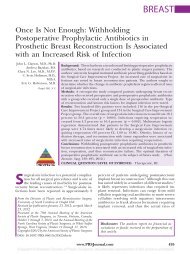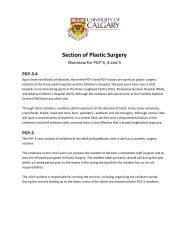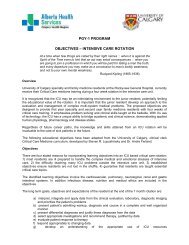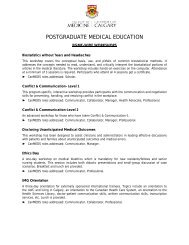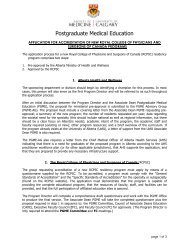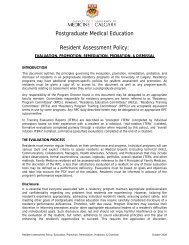Your Faculty / Fall 2005 - Faculty of Medicine - University of Calgary
Your Faculty / Fall 2005 - Faculty of Medicine - University of Calgary
Your Faculty / Fall 2005 - Faculty of Medicine - University of Calgary
You also want an ePaper? Increase the reach of your titles
YUMPU automatically turns print PDFs into web optimized ePapers that Google loves.
12<br />
Research <strong>Your</strong> <strong>Faculty</strong> / <strong>Fall</strong> <strong>2005</strong><br />
Mouse Prion Initiative<br />
Investigating genetic mutations<br />
and protein misfolding<br />
By Natalie St-Denis<br />
Dr. Frank Jirik<br />
A<br />
ll mammals carry the prion gene – a gene that scientists have linked<br />
to the development <strong>of</strong> bovine spongiform encephalopathy (BSE)<br />
in cows. And although extremely rare, extensive media coverage has<br />
brought mad cow disease into our everyday vernacular. The prion<br />
gene also has links to chronic wasting disease (CWD) in deer and to<br />
a degenerative brain disease that spontaneously develops in humans,<br />
known as Creutzfeldt-Jakob disease (CJD).<br />
So how does a healthy prion protein misfold into a shape that<br />
triggers a deadly disease – transforming a healthy, vibrant brain into<br />
a spongy mass? That’s a question Dr. Frank Jirik, from the Department<br />
<strong>of</strong> Biochemistry and Molecular Biology in the <strong>Faculty</strong> <strong>of</strong> <strong>Medicine</strong><br />
and lead investigator <strong>of</strong> the Mouse Prion Initiative at U <strong>of</strong> C, intends<br />
to tackle. “We want to identify genes and proteins that are linked to<br />
prion protein dysfunction and the subsequent degeneration <strong>of</strong> brain<br />
cells,” says Jirik.<br />
Jirik and his collaborators at the Universities <strong>of</strong> <strong>Calgary</strong>, Alberta<br />
and British Columbia think healthy prion proteins in the brain may,<br />
paradoxically, have a protective quality. “Our intentions are to explore<br />
the kinds <strong>of</strong> environmental factors within the brain that allow prion<br />
proteins to protect neurons. This may lead us to understand the ways<br />
in which the misfolded-infective-form <strong>of</strong> the prion protein damage<br />
brain cells,” says Jirik.<br />
Currently, little is known about how prion diseases emerge and<br />
how they are transmitted from one animal to another. Nor do scientists<br />
understand why some exposed animals become infected while<br />
others don’t. “Since only a small number <strong>of</strong> animals or humans exposed<br />
to infective prions ever come down with the disease, it appears that<br />
genetics play a determining factor on who develops the disease and<br />
how fast the degeneration occurs,” explains Jirik.<br />
The quest to uncover the mysteries behind prion diseases will<br />
take place in controlled and ethically approved laboratory settings<br />
using genetically engineered mice. Jirik and his collaborators will be<br />
working with mice missing the prion gene to determine whether brain<br />
cells undergo spontaneous damage in animals that also lack specific<br />
antioxidant and anti-stress-response-system genes. Dr. Hans Vogel,<br />
another key member <strong>of</strong> the research team, will also investigate prion<br />
protein structure and its tendency to misfold using state-<strong>of</strong>-the-art<br />
protein chemistry techniques.<br />
Team members will also study the course and severity <strong>of</strong> brain<br />
disease in mice that lack various types <strong>of</strong> genes and that are inoculated<br />
with scrapie (the sheep version <strong>of</strong> transmissible spongiform encephalopathies).<br />
“These studies will test the ability <strong>of</strong> a whole range<br />
<strong>of</strong> genes to alter the development and progression <strong>of</strong> prion-triggered<br />
diseases,” says Jirik.<br />
Jirik is optimistic that his multidisciplinary team <strong>of</strong> researchers<br />
will achieve important new insights into the causes and factors that<br />
control the progression <strong>of</strong> prion diseases – insights that will one day<br />
lead the way to potential treatments.<br />
The Mouse Prion Initiative is a three-year program supported by the Alberta Agricultural Research Institute and the National Centers <strong>of</strong> Excellence:<br />
Genetic Diseases Network. <strong>University</strong> <strong>of</strong> <strong>Calgary</strong> researchers from faculties across campus include Drs. Frank Jirik, Janice E.A. Braun, James C. Cross,<br />
Roy A. Gravel, Richard Hawkes, Keith Sharkey, Michael Surette, Hans J. Vogel, Samuel Weiss and Gerald Zamponi. Researchers from the <strong>University</strong><br />
<strong>of</strong> Lethbridge include Dr. Bryan Kol, the <strong>University</strong> <strong>of</strong> British Columbia, Dr. Blair R. Leavitt, and from the <strong>University</strong> <strong>of</strong> Alberta, Dr. Christopher Power.








